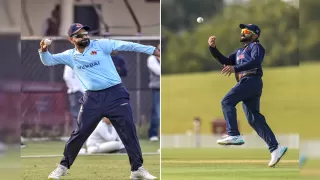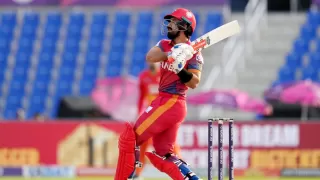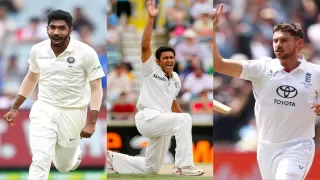Why Jasprit Bumrah Was Not Named India Test Captain Despite Vice-Captain Role?

Why Bumrah Is Not Selected as the Captain Against England Test When He Was the Vice Captain in BGT
India’s cricketing decisions always generate a buzz, and one of the hottest topics this time around is: Why Bumrah is not selected as the captain against England Test when he was the vice captain in BGT? Given Jasprit Bumrah’s impact with the ball, leadership potential, and past captaincy stints, it’s understandable why fans are scratching their heads. After all, he was the vice-captain during the Border-Gavaskar Trophy (BGT) and even led India in tough overseas conditions.
So, what changed between BGT and the upcoming England series? Why was he overlooked for Test captaincy when Rohit Sharma stepped down? Let’s break it all down, one step at a time.
Bumrah’s Fitness Woes: The Elephant in the Room
The most significant reason behind Bumrah not being chosen as captain is, plain and simple, his fitness. Bumrah has had a rocky road when it comes to injuries, especially with his back.
Back in January, during the Sydney Test against Australia, he suffered a stress reaction in his back. This wasn’t just a niggle he had to walk off mid-match and didn't return to bowl. That’s a big red flag for any fast bowler, let alone one considered for captaincy duties.
The decision-makers in Indian cricket, including Chief Selector Ajit Agarkar, have made it clear that Bumrah won’t be playing all five Tests in the upcoming England series. He might feature in three or four, but definitely not all five. That alone makes it tricky to hand over the leadership reins. If your captain might miss games mid-series, the whole leadership structure becomes unstable.
Agarkar was frank about it: “He’s more important to us as a bowler. We’d rather have him fit and bowling at his best than worry about putting extra responsibility on his shoulders.”
Workload Management: A Delicate Balancing Act

Fast bowlers and back injuries are a tale as old as time, and Bumrah is no exception. Managing his workload has become a top priority for the Indian team management. After all, this is someone who underwent back surgery in 2023 and is just a few months removed from a significant layoff.
Take a closer look at his recent workload:
| Series | Overs Bowled | Wickets | Average | Strike Rate |
|---|---|---|---|---|
| Australia Tour | 152.1 | 32 | 13+ | 28.3 |
By the end of the tour, scans revealed back spasms, which later turned out to be stress reactions.
Experts like Shane Bond (another fast bowler who had to retire early due to chronic back issues) have chimed in on this too. Bond warned that pushing Bumrah too hard, especially so soon after the IPL, could lead to a career-ending injury.
- Back injury risk
- Quick turnaround from IPL to Test cricket
- Future tournaments like the World Cup at stake
Workload management has moved from being a buzzword to a non-negotiable reality. Bumrah switching directly from IPL (T20) cricket to a grueling five-match Test series in England is already asking a lot. Making him captain on top of that? It’s a bridge too far.
Captaincy Is a Full-Time Job, Not a Part-Time Honor
Let’s be real, being the captain of the Indian cricket team is no walk in the park. It's not just about setting fields or making bowling changes. It means managing the egos and emotions of 15-16 individuals, dealing with press conferences, taking tactical calls under pressure, and being the face of the team both on and off the field.
Bumrah has shown he can do it. He led India at Edgbaston in 2022 and again in Perth and Sydney. And he did a commendable job. But doing it as a fill-in is different from holding the job long-term.
Agarkar addressed this point directly. He said Bumrah was part of the leadership discussion, but because he wouldn’t be available for all the Tests, his name was dropped from serious consideration.
Also, let's not forget: Captaincy adds mental and emotional strain, something that could impact his bowling. And that’s the last thing India needs. In Tests, Bumrah isn’t just a bowler, he’s a match-winner. In England, where conditions often favor fast bowlers, his role becomes even more crucial.
By not giving him the captaincy, the selectors are essentially saying: “We want Bumrah the bowler, not Bumrah the overworked captain.”
Why Shubman Gill? The Search for a Long-Term Leader
With Rohit Sharma stepping down, the selectors had a big decision to make: Who should be India’s next Test captain? According to Agarkar, Shubman Gill was the “unanimous” choice.
- He is young and fit
- Expected to play all matches
- Long-term leadership potential
Now that might raise a few eyebrows, Gill is young, relatively inexperienced, and hasn't led much in domestic or international cricket. But the logic is about long-term planning. The selectors are betting on a captain who can grow into the role over the next several years, not someone who might have to be rotated out due to injuries.
Even Bumrah himself seems on board. Agarkar mentioned that they spoke to him about it, and he understood the logic. “He’s okay with it,” Agarkar said. “He’d rather look after himself and be bowling fit.”
It’s clear the team isn’t closing the door on Bumrah as a future captain, just not now, and not at the cost of his health.
Conclusion: Right Decision, Even If It’s a Tough Pill to Swallow
So, to wrap it all up: Why Bumrah is not selected as the captain against England Test when he was the vice captain in BGT? It boils down to a combination of fitness concerns, workload management, and long-term planning.
Yes, Bumrah is an incredible cricketer, a generational talent who has already etched his name in Indian cricket history. But giving him the captaincy now would have meant risking his health and potentially shortening his career. And that’s not a gamble worth taking.
The selectors have chosen a path that keeps Bumrah in peak condition, even if it means passing over him for the leadership role for now. Shubman Gill may be a bold choice, but he represents the future. And in the grand scheme of things, keeping Bumrah fit and firing might just be the best leadership decision the team could make.
It’s not about who wears the armband, it’s about who wins the matches. And as long as Bumrah is steaming in from the pavilion end, India’s in good hands.
Disclaimer
Possible11 is a sports news platform that provides live scores, player statistics, and tournament updates for informational and educational purposes only. We comply with the Online Gaming Bill, 2025 (India) and do not promote or engage with fantasy sports, betting, or real-money gaming platforms. All content is intended solely to enhance the sports experience. Possible11 is not affiliated with any fantasy or gambling applications and is not responsible for any financial gains or losses incurred on external platforms.












Give Your Feedback